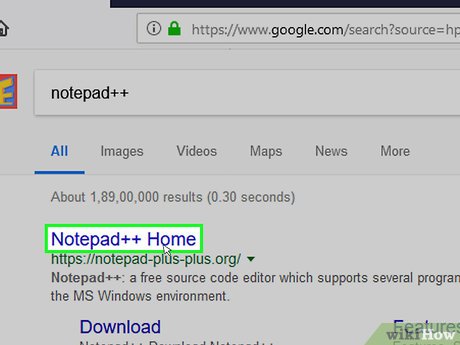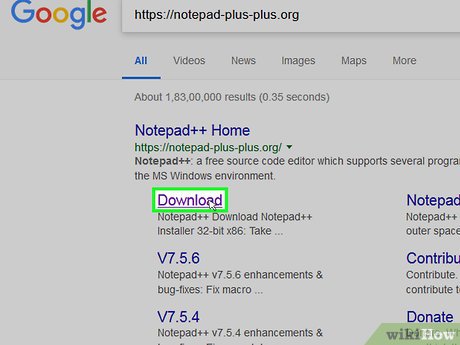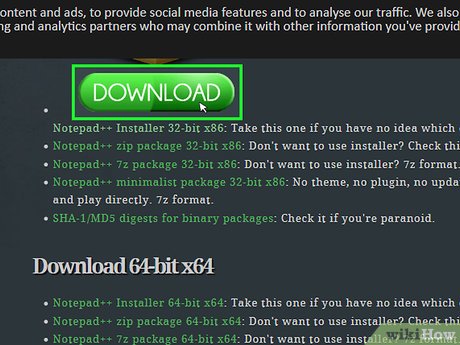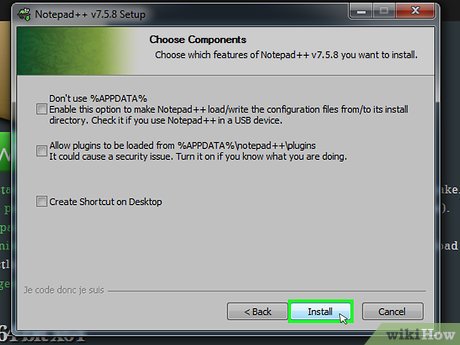How to Use Notepad++
Part 1 of 5:
Installing
-
 Open the Notepad++ website. Go to https://notepad-plus-plus.org/ in your browser.
Open the Notepad++ website. Go to https://notepad-plus-plus.org/ in your browser. -
 Click download. This tab is on the upper-left side of the page.
Click download. This tab is on the upper-left side of the page. -
 Click DOWNLOAD. It's a green button in the middle of the page. The Notepad++ installer will begin downloading.
Click DOWNLOAD. It's a green button in the middle of the page. The Notepad++ installer will begin downloading.- Depending on your browser settings, you may have to select a save location or confirm the download before continuing.
-
 Double-click the setup file. It resembles a green frog.
Double-click the setup file. It resembles a green frog. -
 Click Yes when prompted. The installation window will open.
Click Yes when prompted. The installation window will open. -
 Select a language. Click the language drop-down box, then click the language that you want to use.
Select a language. Click the language drop-down box, then click the language that you want to use. -
 Click OK. It's at the bottom of the Language window.
Click OK. It's at the bottom of the Language window. -
 Follow the on-screen prompts. Do the following:
Follow the on-screen prompts. Do the following:- Click Next
- Click I Agree
- Click Next
- Click Next
- Check advanced options, then click Install
-
 Click Finish. As long as you leave the "Run Notepad++" option checked, doing so will both close the installation window and open Notepad++.
Click Finish. As long as you leave the "Run Notepad++" option checked, doing so will both close the installation window and open Notepad++.
Part 2 of 5:
Setting up Notepad++
-
 Open Notepad++ if it isn't open. Double-click the Notepad++ app icon, which resembles a white pad with a green frog on it.
Open Notepad++ if it isn't open. Double-click the Notepad++ app icon, which resembles a white pad with a green frog on it. -
 Delete any text currently in Notepad++. You'll usually see some developer notes here, so just highlight and delete them.
Delete any text currently in Notepad++. You'll usually see some developer notes here, so just highlight and delete them. -
 Click Settings. This tab is at the top of the Notepad++ window. Clicking it prompts a drop-down menu.
Click Settings. This tab is at the top of the Notepad++ window. Clicking it prompts a drop-down menu. -
 Click Preferences…. It's in the Settings drop-down menu. Doing so opens the Preferences window.
Click Preferences…. It's in the Settings drop-down menu. Doing so opens the Preferences window. -
 Review your Notepad++ settings. Look over the settings in the middle of the window, or click a tab on the left side of the Preferences window to change the category of settings that you're viewing.
Review your Notepad++ settings. Look over the settings in the middle of the window, or click a tab on the left side of the Preferences window to change the category of settings that you're viewing.- You can change these settings to your liking, but be careful not to change anything that you don't understand.
-
 Click Close. It's at the bottom of the Preferences window. Doing so saves any changes and closes the window.
Click Close. It's at the bottom of the Preferences window. Doing so saves any changes and closes the window. -
 Review the menu buttons. Near the top of the Notepad++ window, you'll see a row of colored buttons. Hovering your mouse over each of the buttons will show you what each button does.
Review the menu buttons. Near the top of the Notepad++ window, you'll see a row of colored buttons. Hovering your mouse over each of the buttons will show you what each button does.- For example, the purple floppy disk-shaped icon in the upper-left side of the window saves your progress on a project when clicked.
-
 Decide on a language. This article covers examples for C++, Batch, and HTML coding, but you can use almost any language that you want to with Notepad++. Once you have a language picked out, you can proceed with actually using Notepad++ to create a program.
Decide on a language. This article covers examples for C++, Batch, and HTML coding, but you can use almost any language that you want to with Notepad++. Once you have a language picked out, you can proceed with actually using Notepad++ to create a program.
Part 3 of 5:
Creating a Simple C++ Program
-
 Click the Language tab. It's at the top of the window. Clicking it prompts a drop-down menu.
Click the Language tab. It's at the top of the window. Clicking it prompts a drop-down menu. -
 Select C. You'll find this option in the Language drop-down menu. A pop-out menu will appear.
Select C. You'll find this option in the Language drop-down menu. A pop-out menu will appear. -
 Click C++. It's in the pop-out menu. Most programmers' first experiences with C++ involve creating a program that says "Hello, World!" when run, so that's what you'll do here.[1]
Click C++. It's in the pop-out menu. Most programmers' first experiences with C++ involve creating a program that says "Hello, World!" when run, so that's what you'll do here.[1] -
 Add a title to your program. Type in
Add a title to your program. Type in//followed by your program's title (e.g., "My first program"), then press ↵ Enter.- Any text in a line that's typed after two slash marks won't be read as code.
- For example: to entitle your program "Hi Earth", you'd type
//Hi Earthinto Notepad++.
-
 Enter the preprocessor command. Type
Enter the preprocessor command. Type#includeinto Notepad++, then press ↵ Enter. This command instructs C++ to run the following lines of code as a program. -
 Declare the program's function. Type
Declare the program's function. Typeint main ()into Notepad++, then press ↵ Enter. -
 Add an open bracket. Type
Add an open bracket. Type{into Notepad++, then press ↵ Enter. Your program's main code will go between this open bracket and a closed bracket later. -
 Enter your program's execution code. Type
Enter your program's execution code. Typestd::cout << "Hello World!";into Notepad++ and press ↵ Enter. -
 Add a closed bracket. Type
Add a closed bracket. Type}into Notepad++. This closes the program's execution phase. -
 Review your program. It should look something like this:
Review your program. It should look something like this://Hi Earth#includeint main (){std::cout << "Hello World!";}
-
 Save your program. Click File, then click Save As... in the drop-down menu, enter a name for your program, select a save location, and click Save.
Save your program. Click File, then click Save As... in the drop-down menu, enter a name for your program, select a save location, and click Save.- If you have a program on your computer that can run C++, you should be able to open your Hello World program in it.
Part 4 of 5:
Creating a Simple Batch Program
-
 Click the Language tab. It's at the top of the window. Clicking it prompts a drop-down menu.
Click the Language tab. It's at the top of the window. Clicking it prompts a drop-down menu. -
 Select B. You'll find this option in the Language drop-down menu. A pop-out menu will appear.
Select B. You'll find this option in the Language drop-down menu. A pop-out menu will appear. -
 Click Batch. It's in the pop-out menu. Batch is a modified version of the commands that you use in Command Prompt, so any Batch file will open in Command Prompt.[2]
Click Batch. It's in the pop-out menu. Batch is a modified version of the commands that you use in Command Prompt, so any Batch file will open in Command Prompt.[2] -
 Enter the "echo" command. Type
Enter the "echo" command. Type@echo offinto Notepad++ and press ↵ Enter. -
 Add a title for your program. Type in
Add a title for your program. Type inTitle textand press ↵ Enter, making sure to replace "text" with your preferred title.- When you run the program, the title text is what will display at the top of the Command Prompt window.
-
 Enter display text. Type in
Enter display text. Type inecho textand press ↵ Enter. Replace "text" with whatever you want Command Prompt to display.- For example, if you want Command Prompt to say "Humans are superior!", you'd type
echo Humans are superior!into Notepad++.
- For example, if you want Command Prompt to say "Humans are superior!", you'd type
-
 Halt the program. Type
Halt the program. Typepauseinto Notepad++ to indicate the end of the program. -
 Review your code. It should look something like this:
Review your code. It should look something like this:@echo offTitle Improved Command Promptecho Humans are superior!pause
-
 Save your program. Click File, then click Save As... in the drop-down menu, enter a name for your program, select a save location, and click Save.
Save your program. Click File, then click Save As... in the drop-down menu, enter a name for your program, select a save location, and click Save.- If you want to run your program, simply find it in its save location and double-click it to do so.
Part 5 of 5:
Creating a Simple HTML Program
-
 Click the Language tab. It's at the top of the window. Clicking it prompts a drop-down menu.
Click the Language tab. It's at the top of the window. Clicking it prompts a drop-down menu. -
 Select H. You'll find this option in the Language drop-down menu. A pop-out menu will appear.
Select H. You'll find this option in the Language drop-down menu. A pop-out menu will appear. -
 Click HTML. It's in the pop-out menu. HTML is commonly used for website pages, so you'll be creating a basic webpage heading and subheading.[3]
Click HTML. It's in the pop-out menu. HTML is commonly used for website pages, so you'll be creating a basic webpage heading and subheading.[3] -
 Enter your document header. Type
Enter your document header. Typeinto Notepad++, then press ↵ Enter. -
 Add the "html" tag. Type
Add the "html" tag. Typeinto Notepad++ and press ↵ Enter. -
 Add the "body" tag. Type
Add the "body" tag. Typeinto Notepad++ and press ↵ Enter. This indicates that you'll be entering a section of text or other body information. -
 Enter your page's heading. Type in
Enter your page's heading. Type intext
and press ↵ Enter, making sure to replace the "text" section with your preferred page heading.- For example: to set your heading as "Welcome to my Swamp", you would type
Welcome to my Swamp
into Notepad++.
- For example: to set your heading as "Welcome to my Swamp", you would type
-
 Add text below the heading. Type in
Add text below the heading. Type intext
and press ↵ Enter. You'll replace "text" with your preferred text (e.g., "Make yourself right at home!"). -
 Close the "html" and "body" tags. Type in
Close the "html" and "body" tags. Type inand press ↵ Enter, then type in. -
 Review your code. It should look like this:
Review your code. It should look like this:-
Welcome to my Swamp
-
Make yourself right at home!
-
 Save your program. Click File, then click Save As... in the drop-down menu, enter a name for your program, select a save location, and click Save.
Save your program. Click File, then click Save As... in the drop-down menu, enter a name for your program, select a save location, and click Save.- As long as you select your language before saving, Notepad++ will choose the correct file format for you.
- You should be able to open your HTML file in any web browser.
5 ★ | 1 Vote
You should read it
- What is Notepad ++? Compare Notepad ++ and regular Notepad
- These 'hack' tips are only Notepad can do
- How to quickly open the data file with the Notepad editor
- How to activate and experience the new interface of Notepad in Windows 11
- Summary of useful shortcuts when using Notepad
- Steps to find and replace text in Notepad on Windows 10
- How to End a Program on a PC
- Tips to set an encryption password for NotePad files
May be interested
- How to open Notepad with admin rights
 the 'notepad access denied' error usually occurs when you try to modify the system file from a standard user account on the pc. you will need to open notepad with admin rights to fix the error. there are many ways to run notepad with admin rights.
the 'notepad access denied' error usually occurs when you try to modify the system file from a standard user account on the pc. you will need to open notepad with admin rights to fix the error. there are many ways to run notepad with admin rights. - How to create an Excel formula in Notepad ++
 when entering excel formulas in notepad ++, there will be additional features highlighting, highlighting, and suggestion. the following article will guide you how to set up an excel input formula in notepad ++.
when entering excel formulas in notepad ++, there will be additional features highlighting, highlighting, and suggestion. the following article will guide you how to set up an excel input formula in notepad ++. - Notepad will be absent from the Store on Windows 10
 microsoft has just changed its mind, not moving notepad to the store in the upcoming 20h1 update.
microsoft has just changed its mind, not moving notepad to the store in the upcoming 20h1 update. - 7 ways to fix Notepad not opening error on Windows
 notepad is a simple text editor that comes pre-installed on your windows computer. you can use it to view, create and edit text files whenever needed. but what if windows can't open notepad and you can't use it?
notepad is a simple text editor that comes pre-installed on your windows computer. you can use it to view, create and edit text files whenever needed. but what if windows can't open notepad and you can't use it? - Using Notepad ++ compare two files with a plugin
 notepad ++ is a free, open source code and text editor with lots of features for both casual users and programmers.
notepad ++ is a free, open source code and text editor with lots of features for both casual users and programmers. - How to create a free pronunciation tool on Windows by using Notepad
 no need to download any software and install it. just use notepad, copy some lines of code and save the file with the extension extension vbs to create a free pronunciation tool. the steps are quite simple, even people with low computer skills can do it.
no need to download any software and install it. just use notepad, copy some lines of code and save the file with the extension extension vbs to create a free pronunciation tool. the steps are quite simple, even people with low computer skills can do it. - Use Notepad to make the keyboard automatically type any text repeatedly
 although notepad has been around for a long time, users only know notepad with the simple text editor without knowing that notepad has many other useful features. one of those features makes the keyboard automatically type any text continuously.
although notepad has been around for a long time, users only know notepad with the simple text editor without knowing that notepad has many other useful features. one of those features makes the keyboard automatically type any text continuously. - Differences between Notepad and WordPad in Windows
 if you have been properly trained in microsoft word, you have probably never 'touched' other editing programs on windows such as notepad and wordpad. both notepad and wordpad are developed by microsoft itself, and are integrated on windows versions, however notepad and wordpad only support and cannot be compared with word. to better understand the difference between notepad and worpad in windows, please refer to the article below.
if you have been properly trained in microsoft word, you have probably never 'touched' other editing programs on windows such as notepad and wordpad. both notepad and wordpad are developed by microsoft itself, and are integrated on windows versions, however notepad and wordpad only support and cannot be compared with word. to better understand the difference between notepad and worpad in windows, please refer to the article below. - 8 quick ways to use the browser like Notepad
 when you surf the web or work inside the browser, you should have a notepad to write ideas and information or even write emails. a browser-based notepad can be very helpful for you.
when you surf the web or work inside the browser, you should have a notepad to write ideas and information or even write emails. a browser-based notepad can be very helpful for you. - How to Make a Program Using Notepad
 this wikihow teaches you how to use your windows computer's notepad app to create a program. to do this, you'll type a program's code line-by-line into notepad and then save the notepad file as the programming language's preferred format....
this wikihow teaches you how to use your windows computer's notepad app to create a program. to do this, you'll type a program's code line-by-line into notepad and then save the notepad file as the programming language's preferred format....


















































 How to Add a Check Mark to a Word Document
How to Add a Check Mark to a Word Document How to Create Audio Notes in Evernote
How to Create Audio Notes in Evernote How to Install and Use Evernote
How to Install and Use Evernote How to Write with Penultimate
How to Write with Penultimate How to Use Tags in Evernote
How to Use Tags in Evernote How to Uninstall Evernote
How to Uninstall Evernote